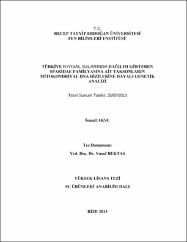| dc.description.abstract | Mercan balıkları en değerli balık türleri arasında olup tropik ve sıcak kıyısal sularda geniş dağılım gösteren 33 genusa ait yaklaşık 115 türden oluşmaktadır. Sparidae içindeki genus ve alt familya ilişkilerini izah edebilmek için Akdeniz, Ege, Marmara ve Karadeniz?i içeren Türkiye kıyı suları için tanımlanan 22 mercan türünün dört mitokondriyal DNA bölgesi (16S rDNA, COI, Cyt b genleri ve kontrol bölgesi)?nin 3562 bç?lik segmenti analiz edilmiştir. Dört farklı metot (NJ, MP, ML ve BI) kullanılarak oluşturulan filogenetik ağaçlar parafiletik alt familyalara sahip Sparidae familyasının monofilisini göstermiştir. Türk kıyı sularındaki sparid türleri, beslenme stratejileri ve diş yapılarına göre Sparidae familyasını 3 ila 6 alt familyaya ayıran önceki taksonomik hipotezlerin aksine iki ana büyük gruba ayrılmıştır. Genetik analizlerle elde edilen filogenetik ağaçlar Sparidae familyası içindeki alt familyaların varlığını izah edemez. Bu nedenle bu tekniklerle belirlenen familya altı yapılanmayı destekleyecek ve bu gruplar içinde tutarlı olacak birleştirici karakterler araştırılmalıdır ve Sparidae familyası içindeki genuslar arasındaki filogeni yeniden oluşturulmalıdır. Anahtar Kelimeler: Sparidae, mtDNA, filogeni, Türkiye kıyısal suları Seabreams are among the most valuable fish species and consist of approximately 115 species in 33 genera that are largely distributed in tropical and temperate coastal waters. We analyzed a 3562 bp segment of the four mitochondrial regions (16S rDNA, COI, Cyt b genes and control region) of 22 seabream species identified for Turkish coastal waters including the Mediterranean, Aegean, Marmara and Black Sea to clarify their genus and subfamily level relationships. The phylogenetic trees constructed using four different methods (NJ, MP, ML and BI) showed monophyly of the family Sparidae with paraphyletic their subfamilies. The sparid fishes in Turkish waters are divided into two major groups that contradicts the previous taxonomic hypothesis, which divided the family into three or six subfamily based on their feeding strategies and dentition. The phylogenetic structure obtained with genetic analysis does not explain the presence of subfamilies within Sparidae. Therefore, the unifying characters supporting the existence of these subfamilies within the Sparidae should be investigated. It should be necessary to reconstruct phylogeny between genera within Sparidae. Keywords: Sparidae, mtDNA, phylogeny, Turkish coastal waters | en_US |


















